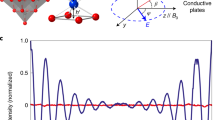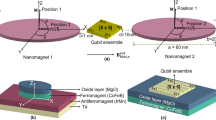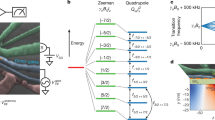Abstract
Quantum control of individual spins in condensed-matter devices is an emerging field with a wide range of applications, from nanospintronics1,2 to quantum computing3. The electron, possessing spin and orbital degrees of freedom, is conventionally used as the carrier of quantum information in proposed devices4,5,6,7,8,9. However, electrons couple strongly to the environment, and so have very short relaxation and coherence times. It is therefore extremely difficult to achieve quantum coherence and stable entanglement of electron spins. Alternative concepts propose nuclear spins as the building blocks for quantum computing10, because such spins are extremely well isolated from the environment and less prone to decoherence. However, weak coupling comes at a price: it remains challenging to address and manipulate individual nuclear spins11,12,13,14. Here we show that the nuclear spin of an individual metal atom embedded in a single-molecule magnet can be read out electronically. The observed long lifetimes (tens of seconds) and relaxation characteristics of nuclear spin at the single-atom scale open the way to a completely new world of devices in which quantum logic may be implemented.
This is a preview of subscription content, access via your institution
Access options
Subscribe to this journal
Receive 51 print issues and online access
$199.00 per year
only $3.90 per issue
Buy this article
- Purchase on Springer Link
- Instant access to full article PDF
Prices may be subject to local taxes which are calculated during checkout




Similar content being viewed by others
References
Awschalom, D. D., Loss, D. & Samarth, N. Semiconductor Spintronics and Quantum Computation (Springer, 2002)
Zutic, I., Fabian, J. & Das Sarma, S. Spintronics: fundamentals and applications. Rev. Mod. Phys. 76, 323–410 (2004)
Nielsen, M. A. & Chuang, I. L. Quantum Computation and Quantum Information (Cambridge Univ. Press, 2000)
Loss, D. & DiVincenzo, D. P. Quantum computation with quantum dots. Phys. Rev. A 57, 120–126 (1998)
Imamoglu, A. et al. Quantum information processing using quantum dot spins and cavity QED. Phys. Rev. Lett. 83, 4204–4207 (1999)
Eble, B. et al. Hole–nuclear spin interaction in quantum dots. Phys. Rev. Lett. 102, 1–4 (2009)
Jelezko, F., Gaebel, T., Popa, I., Gruber, A. & Wrachtrup, J. Observation of coherent oscillations in a single electron spin. Phys. Rev. Lett. 92, 1–4 (2004)
Vrijen, R. et al. Electron-spin-resonance transistors for quantum computing in silicon-germanium heterostructures. Phys. Rev. A. 62, 1–10 (2000)
Leuenberger, M. N. & Loss, D. Quantum computing in molecular magnets. Nature 410, 789–793 (2001)
Kane, B. E. A silicon-based nuclear spin quantum computer. Nature 393, 133–137 (1998)
Chuang, I. L., Gershenfeld, N. & Kubinec, M. Experimental implementation of fast quantum searching. Nature 393, 143–146 (1998)
Chuang, I. L., Vandersypen, L. M. K., Zhou, X., Leung, D. W. & Lloyd, S. Experimental realization of a quantum algorithm. Phys. Rev. Lett. 80, 3408–3411 (1998)
DiVincenzo, D. P. Two-bit gates are universal for quantum computation. Phys. Rev. A. 51, 1015–1022 (1995)
Berman, G. P., Doolen, G. D., Hammel, P. C. & Tsifrinovich, V. I. Solid-state nuclear-spin quantum computer based on magnetic resonance force microscopy. Phys. Rev. B 61, 14694–14699 (2000)
Neumann, P. et al. Single-shot readout of a single nuclear spin. Science 329, 542–544 (2010)
Bogani, L. & Wernsdorfer, W. Molecular spintronics using single-molecule magnets. Nature Mater. 7, 179–186 (2008)
Friedman, J. R., Sarachik, M. P., Tejada, J. & Ziolo, R. Macroscopic measurement of resonant magnetization tunnelling in high-spin molecules. Phys. Rev. Lett. 76, 3830–3833 (1996)
Thomas, L. et al. Macroscopic quantum tunnelling of magnetization in a single crystal of nanomagnets. Nature 383, 145–147 (1996)
Wernsdorfer, W. & Sessoli, R. Quantum phase interference and parity effects in magnetic molecular clusters. Science 284, 133–135 (1999)
Ardavan, A. et al. Will spin-relaxation times in molecular magnets permit quantum information processing? Phys. Rev. Lett. 98, 1–4 (2007)
Bertaina, S. et al. Quantum oscillations in a molecular magnet. Nature 453, 203–206 (2008)
Komeda, T. et al. Observation and electric current control of a local spin in a single-molecule magnet. Nature Commun. 2, 217 (2011)
Otte, A. F. et al. The role of magnetic anisotropy in the Kondo effect. Nature Phys. 4, 847–850 (2008)
Heersche, H. B. et al. Electron transport through single Mn12 molecular magnets. Phys. Rev. Lett. 96, 206801 (2006)
Zyazin, A. S. et al. Electric field controlled magnetic anisotropy in a single molecule. Nano Lett. 10, 3307–3311 (2010)
Urdampilleta, M., Cleuziou, J.-P., Klyatskaya, S., Ruben, M. & Wernsdorfer, W. Supramolecular spin valves. Nature Mater. 10, 502–506 (2011)
Park, H., Lim, A. K. L., Alivisatos, A. P., Park, J. & McEuen, P. L. Fabrication of metallic electrodes with nanometer separation by electromigration. Appl. Phys. Lett. 75, 301–303 (1999)
Stepanow, S. et al. Spin and orbital magnetic moment anisotropies of monodispersed bis(phthalocyaninato)terbium on a copper surface. Supp. Inf. J. Am. Chem. Soc. 132, 11900–11901 (2010)
Ishikawa, N., Sugita, M. & Wernsdorfer, W. Quantum tunneling of magnetization in lanthanide single-molecule magnets: bis(phthalocyaninato)terbium and bis(phthalocyaninato)dysprosium anions. Angew. Chem. Int. Ed. 44, 2931–2935 (2005)
Abragam, A. The Principles of Nuclear Magnetism (Oxford Univ. Press, 1994)
Leuenberger, M. N. & Loss, D. The Grover algorithm with large nuclear spins in semiconductors. Phys. Rev. B 68, 165317 (2003)
Acknowledgements
We thank E. Eyraud, D. Lepoittevin, L. Cagnon, R. Haettel, C. Hoarau, V. Reita and P. Rodière for technical contributions and discussions. We thank T. Fournier, T. Crozes, B. Fernandez, S. Dufresnes and G. Julie for lithography development; E. Bonet, C. Thirion and R. Piquerel for help with software development and M. Urdampilleta, S. Thiele, N. Roch, A. Varlet and A. Ralko for discussions. Samples were fabricated in the Nanofab facility of the Néel Institute. This work is partially supported by the French National Research Agency National Programme in Nanosciences and Nanotechnologies (ANR-PNANO) project MolNanoSpin, number ANR-08-NANO-002; European Research Council Advanced Grant MolNanoSpin, number 226558; ICT-2007.8.0 Future Emerging Technologies Open, Quantum Information Processing Specific Targeted Research Project number 211284 MolSpinQIP; the German Research Foundation programme TRR 88 ‘3Met’; Cible 2009; and the Nanosciences Foundation of Grenoble.
Author information
Authors and Affiliations
Contributions
R.V., W.W. and F.B. designed, conducted and analysed the experiments; S.K. and M.R. designed, synthesized and characterized the molecule; R.V., M.R., W.W., and F.B. co-wrote the paper.
Corresponding authors
Ethics declarations
Competing interests
The authors declare no competing financial interests.
Supplementary information
Supplementary Information
This file contains Supplementary Text 1-7, Supplementary Figures 1-7 and additional references. (PDF 2550 kb)
Rights and permissions
About this article
Cite this article
Vincent, R., Klyatskaya, S., Ruben, M. et al. Electronic read-out of a single nuclear spin using a molecular spin transistor. Nature 488, 357–360 (2012). https://doi.org/10.1038/nature11341
Received:
Accepted:
Published:
Issue Date:
DOI: https://doi.org/10.1038/nature11341
This article is cited by
-
Regulation of quantum spin conversions in a single molecular radical
Nature Nanotechnology (2024)
-
Single-electron spin resonance detection by microwave photon counting
Nature (2023)
-
Characterization of just one atom using synchrotron X-rays
Nature (2023)
-
Synthesis, characterization, in vitro antimicrobial activity, DNA binding assay, antioxidant and anti-inflammatory efficacy of trinuclear heterobimetallic complexes of Ni(II) derived by the reaction of [Ni(C13H12N2O)2]Cl2 with dialkyl/diaryl organometallic dichlorides
Research on Chemical Intermediates (2023)
-
Atomically precise control of rotational dynamics in charged rare-earth complexes on a metal surface
Nature Communications (2022)
Comments
By submitting a comment you agree to abide by our Terms and Community Guidelines. If you find something abusive or that does not comply with our terms or guidelines please flag it as inappropriate.



